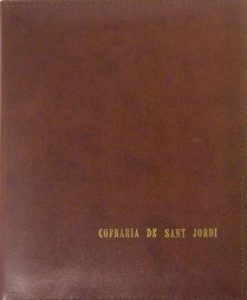
Francisco Berenguer. Plastic artist Professor at the Faculty of Fine Arts Polytechnic University of Valencia
The cover image of this magazine corresponds to a detail of a pictorial work made in tempera, from the Sant Jordi series.
Tempera painting is the oldest known painting technique, if we except the cave paintings. On a wooden table prepared with glue primer, I have reinterpreted those altarpieces from the Middle Ages that achieved great mastery and are a fundamental part of our Art history. The figure of Sant Jordi, treated under an aesthetic close to deconstruction, it allows me to achieve a visual speech of a dreamlike nature. A work that, observed from a certain distance, will remind me of Sant Jordi, but close up view, and in detail, show a universe of brushstrokes, geometric shapes and simple volumes, totally detached from reference.
His invoice has allowed me to approach the tempering technique again, that I learned when I studied Painting at the Faculty of Fine Arts in the late nineties. It was a pictorial technique of simple preparation, which we manufactured by mixing various components (Egg yolk, was in de llina, dammar varnish and intended water) resulting in an emulsion that made it possible to mix the color pigments and obtain a very luminous compact finish reminiscent of both watercolor and gouache, depending on the opacity of the brush strokes.
Its durability is very high, preserving the luminosity characteristics over time, transparency, freshness and delicacy that this technique brings. Good examples are the works of the genius Giotto or the Renaissance Botticelli that after centuries continue to endure in all their splendor. The drying time of this pictorial technique is very fast if the emulsion is not altered with oils or varnishes, which allows painting in layers very easily.
In large-scale pictorial works I usually use wood and not canvas, as a support, which allows me to manipulate parts of the wood surface, either scraping, scaling or gouging certain areas to create concavities that are part of the whole and can be painted later. In the work that corresponds to the cover of this magazine, there are parts of the torso of Sant Jordi and the dragon that have been obtained by carrying out this process, later painting with glazes to achieve depth effects.
Although in this technique the color does not change once dried so it is not necessary to apply final varnishes, in the case of this work I have applied several layers of olive oil (Ili's oil-forge varnish paste and a drying agent) to guarantee its conservation for years.










